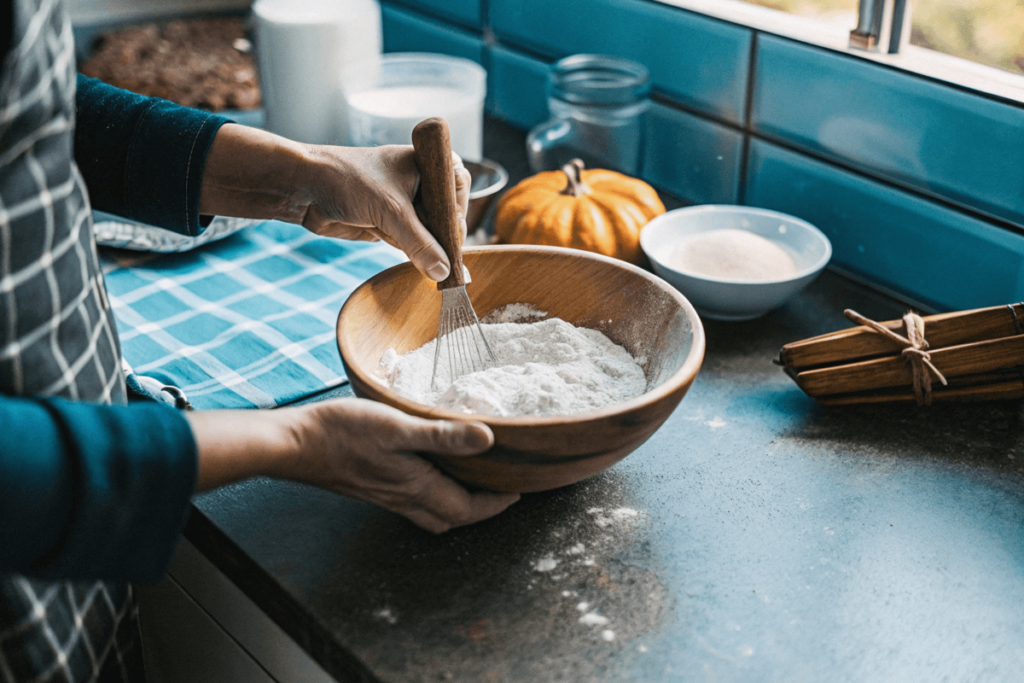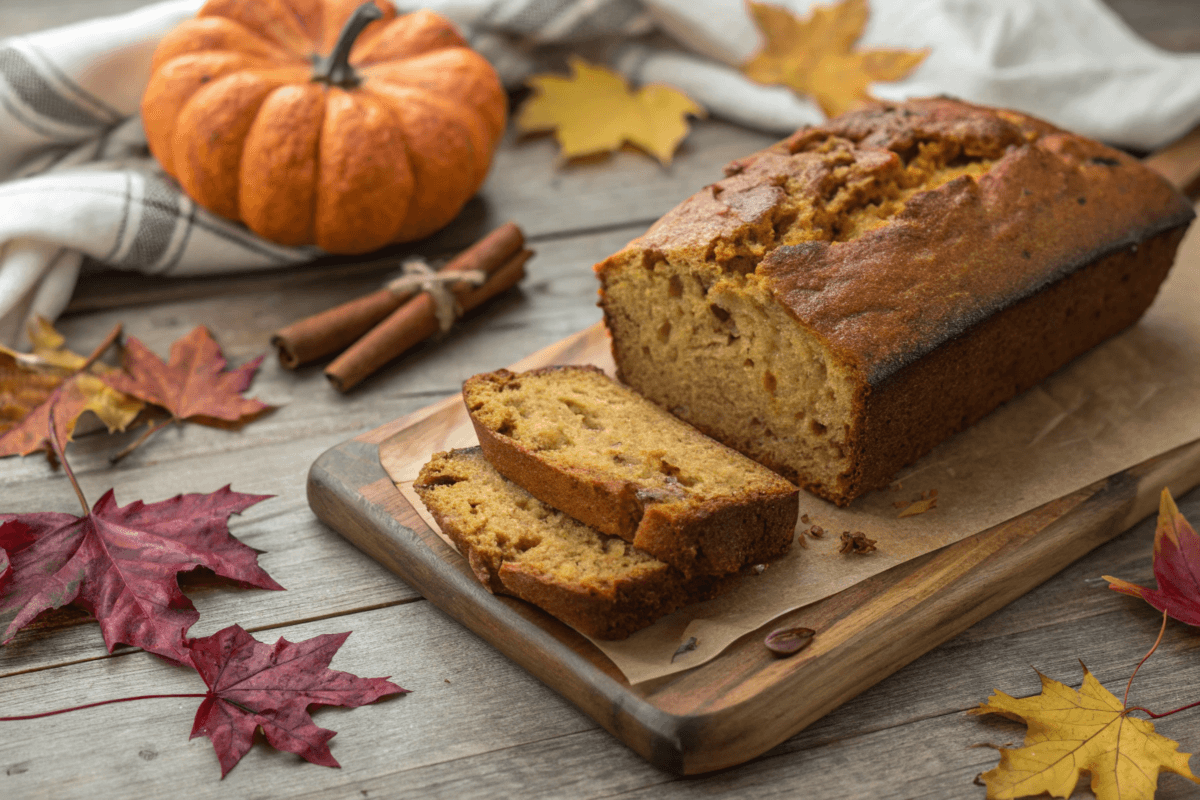How to Make the Perfect Pumpkin Sourdough Bread: A Comprehensive Guide
Baking pumpkin sourdough bread is like capturing the essence of autumn in a single loaf. This delightful bread combines the earthy tang of sourdough with the warm sweetness of pumpkin, creating a versatile treat perfect for any occasion. Whether you’re a seasoned baker or a beginner, this guide covers everything you need to craft a perfect loaf—from ingredients and techniques to troubleshooting and customization ideas. Let’s dive into the cozy world of pumpkin sourdough bread!
Introduction to Pumpkin Sourdough Bread
What is Pumpkin Sourdough Bread?
Pumpkin sourdough bread is a fall-inspired twist on the classic sourdough loaf. By incorporating pumpkin puree into the dough, you get a bread that’s not only moist and flavorful but also visually stunning with its golden-orange hue. The pumpkin complements the tangy sourdough base, offering a unique flavor profile that’s both savory and subtly sweet. It’s bread, but with an autumnal hug baked right in.
The Appeal of Pumpkin in Sourdough
Why add pumpkin to sourdough? Well, aside from its seasonal charm, pumpkin puree adds moisture to the loaf, resulting in a tender crumb. It also pairs beautifully with warm spices like cinnamon, nutmeg, and ginger, enhancing the bread’s comforting flavor. Plus, it’s a creative way to use up canned or fresh pumpkin during the fall.
A Brief History of Sourdough and Seasonal Twists
Sourdough bread has been around for thousands of years, celebrated for its unique fermentation process that creates a tangy flavor and chewy texture. Over time, bakers began experimenting with seasonal ingredients, and pumpkin quickly became a favorite. Today, pumpkin sourdough bread is a staple in many kitchens, combining traditional techniques with modern, festive flavors.
The Essential Ingredients for Pumpkin Sourdough Bread
Key Components of a Sourdough Starter
The foundation of pumpkin sourdough bread lies in the sourdough starter. A lively, well-fed starter ensures your bread rises beautifully and develops its signature tangy flavor. To create one, mix equal parts water and flour, then let it ferment at room temperature. This natural fermentation fosters wild yeast and beneficial bacteria, which give sourdough its unique taste and texture.
If you already have a sourdough starter, make sure it’s bubbly and active before using it in your recipe. Feed it with fresh flour and water 4-6 hours before baking for optimal results.
Why Pumpkin Puree is Ideal for Baking
Pumpkin puree is the star ingredient in this recipe. Its creamy texture and mild sweetness complement sourdough’s tang, creating a perfectly balanced loaf. Not only does it enhance flavor, but it also adds moisture, giving the bread a soft, tender crumb.
When selecting pumpkin puree, opt for 100% pure pumpkin with no added sugar or spices. Canned puree works well, but homemade puree can elevate your loaf with its fresh, natural flavor. Using pumpkin also gives your bread a warm, golden hue that looks as delightful as it tastes.
Optional Add-ins: Spices, Nuts, and More
For an extra touch of flavor, consider adding warm spices like cinnamon, nutmeg, and allspice. These spices pair wonderfully with pumpkin sourdough bread, enhancing its autumnal appeal. You can also fold in chopped nuts, such as pecans or walnuts, for added texture or sprinkle pumpkin seeds on top for a crunchy crust.
For a sweet twist, mix in chocolate chips or dried cranberries, creating a festive loaf perfect for dessert or brunch. The possibilities are endless—get creative and make the recipe your own.
Preparing Your Sourdough Starter for Success
How to Create and Maintain a Sourdough Starter
If you’re new to sourdough, starting from scratch is simpler than you think. Combine equal parts water and unbleached flour in a clean jar and stir until smooth. Cover loosely and let it sit at room temperature. Each day, discard half the mixture and feed it with fresh flour and water.
Within 5-7 days, your starter should become bubbly and tangy-smelling—ready for baking. Regular feeding keeps your starter healthy, so don’t skip this step.
Best Practices for an Active, Bubbly Starter
To ensure your starter is at its peak for baking, feed it a few hours before mixing your dough. Use a 1:1:1 ratio of starter, flour, and water for the feeding. The starter should double in size within 4-6 hours, with visible bubbles and a fruity aroma.
Temperature also plays a key role—keep your starter in a warm spot, around 75-80°F (24-27°C). If your home is chilly, wrap the jar in a towel or place it in a slightly warm oven.
Common Mistakes to Avoid with Starters
Maintaining a sourdough starter requires consistency. Common mistakes include overfeeding (which dilutes the yeast), underfeeding (which starves it), and using bleached flour (which lacks nutrients). Always discard some starter before feeding to maintain balance.
If your starter smells unpleasantly sour or develops mold, it’s best to start fresh. A healthy starter is the backbone of pumpkin sourdough bread, so treat it with care.
Check out Pumpkin Banana Loaf Recipe for another delicious way to use pumpkin in your baking adventures!
Step-by-Step Recipe for Pumpkin Sourdough Bread
Mixing the Dough: Key Ingredients for Pumpkin Sourdough Bread

Making pumpkin sourdough bread begins with combining simple, wholesome ingredients. Start by gathering your active sourdough starter, pumpkin puree, flour, water, salt, and optional spices like cinnamon or nutmeg. These ingredients create a dough that’s soft, flavorful, and ready to rise.
To mix, combine the water, starter, and pumpkin puree in a large bowl, stirring until smooth. Gradually add the flour and salt, mixing until no dry streaks remain. For an even better texture, use your hands to knead the dough gently. If adding spices, incorporate them during this step to ensure they’re evenly distributed.
Shaping the Pumpkin Sourdough Loaf: Tips for Beginners
Once your dough has completed its bulk fermentation (typically 4-6 hours), it’s time to shape it. Lightly flour a clean surface and turn the dough out gently. Fold the edges inward to form a tight round or oval loaf. Avoid overworking the dough to keep the air pockets intact.
Next, place the shaped dough seam-side down in a proofing basket or a bowl lined with a floured cloth. Cover and refrigerate overnight for a slow, cold ferment that enhances the flavor and texture of your loaf.
Baking Pumpkin Sourdough Bread in a Dutch Oven
For the best results, bake your bread in a Dutch oven. Preheat the oven to 450°F (230°C) with the Dutch oven inside. Carefully transfer the dough into the hot pot, score the top with a sharp blade, and cover with the lid. Bake for 20 minutes covered, then remove the lid for an additional 20-25 minutes to achieve a golden crust.
Let the bread cool completely on a wire rack before slicing. This step is crucial—cutting too soon can affect the texture.
Cooling and Storing Your Bread
Once your pumpkin sourdough bread has cooled, store it properly to maintain its freshness. Keep it in a paper bag at room temperature for up to three days. For longer storage, wrap it tightly in plastic wrap or foil and freeze. Thaw at room temperature before serving, and enjoy the cozy flavors of autumn anytime!
Customizing Your Pumpkin Sourdough Bread
Incorporating Spices: Cinnamon, Nutmeg, and More
Spices are an excellent way to make your pumpkin sourdough bread stand out. Classic options like cinnamon, nutmeg, and ginger enhance the pumpkin’s natural sweetness, creating a warm, comforting flavor profile. For a bolder taste, try adding a pinch of cardamom or clove. Stir spices directly into the dough for even distribution.
Adding Texture with Nuts and Seeds
Nuts and seeds not only add crunch but also boost the nutritional value of your loaf. Walnuts, pecans, and sunflower seeds are great choices that complement the bread’s earthy flavor. Sprinkle pumpkin seeds on top before baking for a visually stunning crust that hints at the pumpkin inside.
Creating Sweet Variations: Chocolate Chips or Swirls
Transform your loaf into a dessert-worthy treat by folding in chocolate chips, dried cranberries, or a swirl of brown sugar and cinnamon. These additions turn your bread into the perfect autumn dessert or festive gift. Experiment with different flavors to keep your baking exciting.
For more delicious recipes, check out our Pumpkin Banana Loaf for another way to enjoy the versatility of pumpkin in baking.
Troubleshooting Common Issues
Why Didn’t My Bread Rise?
One of the most common challenges in making pumpkin sourdough bread is achieving the perfect rise. If your bread didn’t rise as expected, it might be due to an underactive sourdough starter. Always ensure your starter is bubbly and fed a few hours before mixing the dough. Additionally, room temperature plays a crucial role—warmer environments encourage better fermentation.
Another possible issue is overproofing, where the dough sits too long during the final rise, weakening its structure. Keep an eye on the dough’s texture, looking for a slightly domed surface rather than flat or collapsing.
How to Fix a Dense Loaf
If your loaf turned out dense, the culprit could be insufficient kneading or mixing. Proper gluten development is essential for a light, airy crumb. Use the stretch-and-fold method during bulk fermentation to strengthen the dough without overworking it.
Too much pumpkin puree can also make the dough too wet, leading to a heavier loaf. Stick to the recommended measurements to maintain the right balance of moisture and structure.
Dealing with Overproofed Dough
Overproofing can result in a deflated loaf with a poor rise. To salvage overproofed dough, reshape it gently, let it rest briefly, and then bake immediately. The final texture may differ slightly, but the flavor of your pumpkin sourdough bread will still shine.
Serving and Pairing Ideas
Perfect Spreads for Pumpkin Sourdough Bread
Pumpkin sourdough bread is incredibly versatile, pairing beautifully with sweet and savory spreads. For a touch of sweetness, try it with honey butter, apple butter, or a dollop of cream cheese. If you prefer savory options, spreads like herbed butter or garlic hummus complement the tangy-sweet flavor of the bread.
To elevate the experience, toast slices lightly for a warm, crunchy texture that enhances the flavor of any topping.
Seasonal Beverages to Accompany Your Loaf
Pairing your pumpkin sourdough bread with the right drink completes the experience. A hot cup of chai, spiced apple cider, or pumpkin spice latte enhances the bread’s autumnal notes. For something more robust, try it with a rich coffee or even a light red wine for a cozy evening treat.
Using Leftover Bread: Croutons, Puddings, and More
Got leftover bread? Don’t let it go to waste! Transform it into crunchy croutons for soups or salads, or use it as the base for a decadent bread pudding. You can even grind stale slices into breadcrumbs for savory recipes like stuffing or casseroles.
This creative use of leftovers ensures you enjoy every bit of your pumpkin sourdough bread while adding variety to your meals.
Frequently Asked Questions (FAQs)
Can I Use Store-Bought Pumpkin Puree?
Absolutely! Store-bought pumpkin puree is a convenient and reliable option for making pumpkin sourdough bread. It saves time without compromising flavor. However, make sure to choose a product labeled “100% pure pumpkin” to avoid added sugars or spices that might affect your bread’s taste and texture.
For those who enjoy a hands-on approach, homemade pumpkin puree works beautifully too. Just be sure to drain any excess moisture to keep your dough from becoming too wet.
What’s the Best Way to Store Pumpkin Sourdough Bread?
To keep your bread fresh, store it in a paper bag or wrapped in a clean kitchen towel at room temperature for up to three days. This method preserves the crust’s crispness while maintaining the bread’s soft interior.
For longer storage, freezing is your best option. Wrap the bread tightly in plastic wrap, then place it in a resealable freezer bag. When ready to eat, thaw at room temperature and reheat in the oven for a just-baked taste.
How Do I Enhance the Flavor Profile?
To elevate the taste of your pumpkin sourdough bread, experiment with spices like cinnamon, nutmeg, and allspice. For added texture and flavor, try folding in mix-ins like chopped pecans, dried cranberries, or even chocolate chips. These small additions can make your loaf truly unforgettable.
Can I Make a Gluten-Free Version?
Yes, but it requires specific adjustments. Gluten-free flours, such as a blend of rice, tapioca, and potato flours, can replace traditional wheat flour. You’ll also need a gluten-free sourdough starter to maintain the tangy flavor. While the texture may differ slightly, you can still enjoy a delicious loaf of pumpkin sourdough bread.
Conclusion and Final Thoughts
Celebrating Seasonal Baking with Pumpkin Sourdough Bread
Baking pumpkin sourdough bread is more than just making bread; it’s a way to embrace the flavors and warmth of the season. The blend of tangy sourdough and sweet pumpkin creates a loaf that’s both comforting and versatile, perfect for breakfast, snacks, or even dinner.
Whether you’re a seasoned baker or just starting out, this guide has everything you need to create a loaf that’s as enjoyable to make as it is to eat. Don’t be afraid to experiment with spices, add-ins, and techniques to make it your own.
Encouraging Experimentation and Creativity in the Kitchen
One of the best parts of baking pumpkin sourdough bread is the freedom to get creative. Try new flavor combinations, explore different textures, and share your creations with friends and family. The process of baking can be as rewarding as the final product, filling your home with the irresistible aroma of fresh, homemade bread.
So, grab your sourdough starter, some pumpkin puree, and your favorite mix-ins, and get baking! Your perfect loaf of pumpkin sourdough bread awaits.

